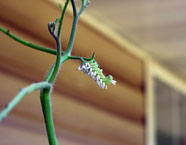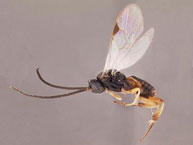home | fall garden | waterfall, pool & stream
Braconid Wasp
The braconid wasp spends a significant portion of its life attached to or within a single host organism. Ultimately, the wasp will kill and sometimes consume the host. The braconid wasp is considered a beneficial insect because it preys on insects that damage plants, fruits, and vegetables. There are 20,000 to 75,000 species that exist worldwide, their size and the fact that there are so many species make them hard to identify. The species found in our garden preys on tomato hornworms. This braconid wasp is less than 1/8th of an inch long, black-brown in color with reddish markings. Female wasps use their long ovipositor (tube-like projection) to lay eggs just under the skin of the hornworm. As the eggs hatch, the larvae feed on the hornworm's internal organs. Larvae eventually chew their way out through the host's skin when they mature. Once outside the larvae pupate spinning tiny oval cocoons that look like insect eggs along the back and sides of the worm. When they emerge as adults, the already weakened hornworm will soon die. With the death of the hornworm, the braconid wasp enables the tomato plant to survive. Therefore, these wasps are a significant control against thousands of other insect species, including many that are considered a pest.
 |
 |
 |
 |
